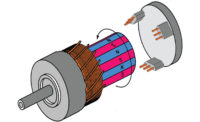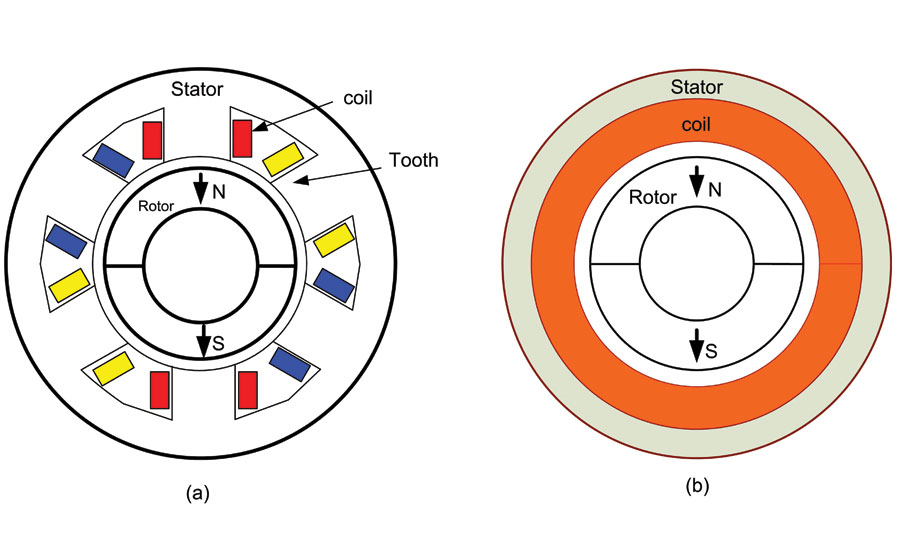Slotless vs. Slotted Brushless DC Motor Design
Learn more about motor options.








Due to their mechanical commutation, brushed dc motors have a limited operational lifetime and are confined to low operating speeds typically less than 12K rpm. This makes them not particularly suitable for certain medical and industrial tool applications. Electronically commutated miniature motors continue to gain interest due to their simple construction and long operational lifetime.
Fig. 1 shows the cross-sectional view of a Brushless DC (BLDC) motor. In slotted BLDC motors (as shown in Fig.1 a), the presence of stator teeth prevents the overall size of the motor from being minimized. Moreover, the winding process becomes progressively more difficult as the motor shrinks in size [1]. On the other hand, the slotless BLDC motor (as shown in Fig.1 b) has either skewed or axial type windings fixed on the cylindrical stator iron core providing several advantages as well as small size.
Although the power density of slotless BLDC motors may be lower than that for equivalent slotted motors, the emergence of high energy permanent magnets (ex: NdFeB and SmCo) and its magnetization arrangements (e.g., radial, parallel and halbach) have promoted a renewed interest in slotless motors [2]. Also, easier manufacturing of the stator core is possible and this allows the design of the motor parts with a low degree of complexity. On the other hand, slotted designs do not take advantage of high energy magnets due to the reduced slot area and therefore reduced ampere turns.
Key takeaways:
-
In slotted design, the thicker teeth are provided to increase the magnetic loading of the motor, but this reduces the slot area and therefore the electrical loading of the motor.
-
Thus, slotted motors do not take the advantage of stronger magnets
In order to obtain mechanical stabilization under high speed operation (ex: 40,000 to 60,000 rpm), the slotless rotor has a two-pole permanent magnet. In addition, the stator core losses are restricted to an acceptable range while the motor operates at high speed. Core losses are relatively small due to its slotless stator structure.
Key takeaways:
-
In slotless motor design, stronger magnets barely impact the saturation level due to higher effective air-gap length
-
Thus the impact of core losses is less at high speed operation
In slotless BLDC motors, the cogging torque is extremely small, reducing the vibration and noise during operation. Also, the inductance is small compared to the slotted motors, therefore more accurate sensor-less driving is possible. However, low inductance results in higher losses if pulse width modulation (PWM) control is applied.
In slotless BLDC motors, the stator winding differs from the conventional slotted motors which are inserted in the slots as shown in Fig.1 a. For example, the windings in the slotless motors can be self-bonded with skewed and cup shaped windings placed on the air gap. This motor can be analyzed in simple two dimensional (2-D) finite element method (FEM) based model, if the rectangular windings or axial coils are used [3].
The table below details the performance of the slotted and slotless BLDC motor.
It can be seen that the removal of iron in the slotless design makes the motor more sensitive to overloading because its thermal time constant is reduced and therefore the stall current is limited.
In summary, the slotted BLDC motors are preferable when the diameter is larger and a higher number of poles are required. Some of the applications of this type of motors are electric vehicles and home appliances. On the other hand, slotless BLDC motor is suitable for smaller diameter size and high speed application. Medical and portable industrial tools are the application examples for this type of motor.
References:
[1] J.M. Seo, J.H. Kim, I.S. Jung and H.K. Jung, “Design and Analysis of Slotless Brushless DC Motor,” IEEE Trans. Ind. Appl., vol. 47, no. 2, pp. 730-735, Mar/Apr., 2011.
[2] Y. Chen, J. Shen and Z. Fang, “Topology and preliminary design of slotless brushless DC motor,” in Proc. IEEE Int. Conf. Electr. Mach. And Drives (IEMDC), pp. 7.1-7.3, 1997.
[3] J. Baudey, C. Baud, and A. M. Rentier, “Axial coil for a slotless electric motor”, US patent 0080975, 2012.
Looking for a reprint of this article?
From high-res PDFs to custom plaques, order your copy today!








